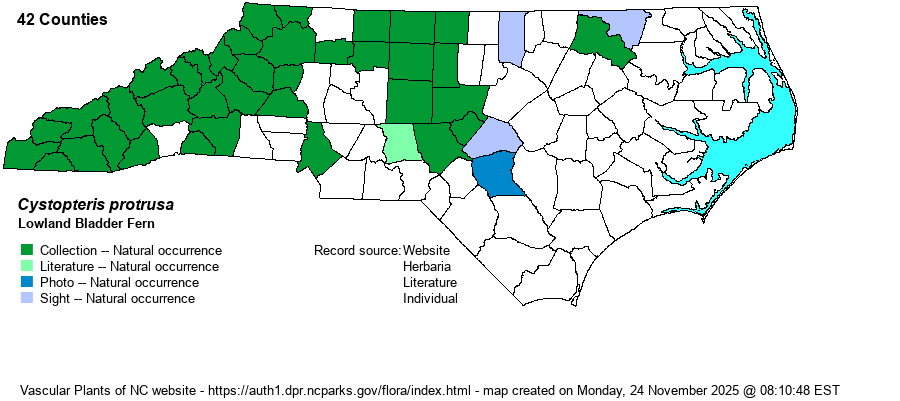| Author | (Weatherby) Blasdell | |
| Distribution | Throughout the Mountains, where there is some confusion with the very similar C. fragilis and probably also with C. tenuis. Also widely scattered across the Piedmont, barely into the western edge of the Coastal Plain along the Roanoke River in Northampton and Halifax counties and along the Cape Fear River in Cumberland County (see photo below).
This is an Eastern and Mideastern species, widespread from CT, NY, and MN south to central AL (very rare in the FL Panhandle), and eastern TX. | |
| Abundance | Frequent to common and widespread in the Mountains. However, uncommon and local in the Piedmont, restricted in habitat to very rich slopes; absent from some eastern and southern counties. Rare and local along the Roanoke River and the Cape Fear River into the upper Coastal Plain. Where it occurs, it may be a patch dominant. | |
| Habitat | This is a species characteristic of mesic soil of very rich and moist shaded forests. It is most often seen in Rich Cove Forests, but it also occurs in Boulderfield Forests, Basic Mesic Forests, and on some moist and shaded rock crevices. It is an indicator species of Basic Mesic Forests where found in the Piedmont and Coastal Plain. Blasdell (1963) states that it "has never been reported to grow on rock to my knowledge." | |
| Phenology | Fruits from April to June. | |
| Identification | This is a familiar fern of rich forests, especially in the Mountains. It is a somewhat small fern that grows in very dense stands. The stipes are glabrous and shorter than the blades, about 4-6 inches long, with the blades averaging 8-9 inches long and about 3 inches wide, somewhat ovate in general outline, widest toward the base but not at the base. The blades are bipinnate, and somewhat pinnatifid (the pinnules with some shallow lobing). As with others in the genus, the sori are in rounded cup-like indusia, located along veins on the undersides of the pinnules. C. fragilis is very similar (and often considered conspecific), but that species has the pinnae typically at right-angles to the rachis, versus pinnae angled upward in C. protrusa and often with the tip curved toward the apex as well; a narrower blade (3-4 times as long as wide) as opposed to 2-3 times as long as wide in C. protrusa; and sharp teeth on the pinnules as opposed to rounded lobes on pinnules in C. protrusa. Lastly, C. fragilis is a species growing on rocks, whereas most populations of C. protrusa grow in rich soil (but rarely on rocks). For separation from the possibly controversial C. tenuis, see that species account. | |
| Taxonomic Comments | This species is at times lumped with C. fragilis, then mostly named as C. fragilis var. protrusa. C. tenuis is often included within either one of these.
| |
| Other Common Name(s) | Southern Fragile Fern, Lowland Bristle Fern, Lowland Fragile Fern | |
| State Rank | S5 | |
| Global Rank | G5 | |
| State Status | | |
| US Status | | |
| USACE-agcp | FAC link |
| USACE-emp | FAC link |

